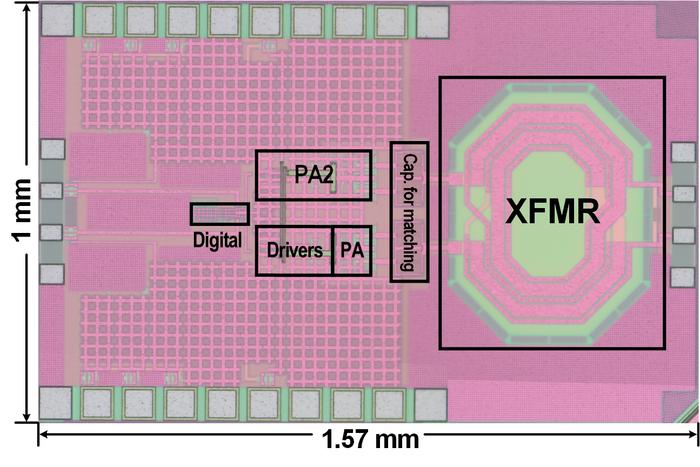
In a groundbreaking advance within the field of wireless communication, researchers from the Institute of Science Tokyo (Science Tokyo), led by Professor Kenichi Okada, have introduced an innovative CORDIC-less digital polar transmitter that promises to revolutionize the efficiency and data throughput of wireless transmitters fundamentally. This new architecture is set to optimize performance for diverse applications requiring high-speed data transmission and enhanced power efficiency, two factors that are increasingly critical in today’s rapidly evolving technology landscape.
The research addresses the escalating demands imposed by the burgeoning Internet of Things (IoT), which necessitates seamless connectivity between a multitude of devices. As wireless communications burgeon in both scope and complexity, the efficiency of transmitters becomes paramount. Traditional digital polar transmitters, while widely used, rely heavily on power-hungry components such as the COordinate Rotation DIgital Computer (CORDIC), which not only consumes significant power but also complicates the issues of linearity inherent in the data transmission process.
The novel CORDIC-less transmitter architecture developed by Okada and his team is an ingenious solution to these challenges. They employ three innovative design strategies that enable simultaneous improvements in power efficiency and data rates without the pitfalls associated with conventional methods. This dual enhancement is a major leap forward, making the design significantly less reliant on the algorithmic complexities and power demands of CORDIC and its related circuitry.
The core of the solution lies in re-encoding input data into a simpler format via Delta-Sigma Modulators (DSMs). By transforming the data into manageable three-level signals, Okada’s team effectively reduces the complexity typical of amplitude-phase combination calculations to a nine-state look-up table. This significant reduction in operational complexity allows for further optimization, minimizing the burdens traditionally associated with multi-bit amplitude and phase generation.
Moreover, the transmitter’s design incorporates mechanisms that allow for linear amplitude and phase modulation. In classic multi-bit schemes, the relevance of device matching becomes paramount, as any mismatch can severely disrupt modulation linearity. To counteract this situation, the researchers implemented quantization techniques that simplify the amplitude quantization process, allowing for a cleaner output—the transmitter can now toggle directly between zero and peak amplitudes without introducing noise-inducing intermediate levels.
In tandem with this, the design intelligently manages phase control by limiting the phase code to just three bits. This approach uses edge-triggered mechanisms rather than interpolating phases, ensuring that the output remains stable and reliable across the required data spectrum. Such inventive methodologies yield a critical improvement: by eschewing disturbance from unnecessary calibration procedures, the transmitter operates more efficiently, consuming less energy while simultaneously delivering higher data rates.
The research further highlights the echelons of performance that can be achieved with this new CORDIC-less architecture. In rigorous testing conditions, the design demonstrated top-tier power efficiency alongside impressive data transmission rates, establishing a benchmark for future developments in wireless transmitter technology. This fused efficiency is of particular significance as it aligns with modern demands where minimizing energy consumption is crucial, especially within battery-operated IoT devices.
The ramifications of this research transcend mere enhancement of existing technology; they mark a pivotal moment in aligning technological progress with societal needs. The Institute of Science Tokyo’s announcement at the upcoming 2025 IEEE International Solid-State Circuits Conference (ISSCC) demonstrates the importance of such innovations in the context of global advancements in wireless communication. By streamlining the transmitter architecture, they’re not just refining technology; they’re enriching the overall user experience in a society increasingly reliant on seamless digital connections.
In conclusion, the CORDIC-less polar transmitter architecture not only introduces substantial efficiency gains but also cultivates a promising foundation for future research and development in wireless communication systems. By reducing power requirements, enhancing data rates, and streamlining operation, this formidable advancement will undoubtedly play a crucial role in the ongoing evolution of IoT devices and the systems that support them, thus elevating overall quality of life.
In a world that demands more from its technology, the research spearheaded by Professor Okada and his team serves as a key milestone, highlighting the potential for substantial improvements in wireless communications. With the stage set for presentations and discussions surrounding these innovations, the scientific community looks toward the realization of these advancements with eager anticipation.
As we move forward, the integration of such efficiency-optimized technologies will undoubtedly foster greater connectivity and innovation, ultimately enabling a smarter, more interconnected future for all.
Subject of Research: Wireless Transmitter Efficiency
Article Title: A Power-Efficient CORDIC-less Digital Polar Transmitter Using 1b DSM-Based PA Supporting 256-QAM
News Publication Date: 14-Feb-2025
Web References: Not applicable
References: Not applicable
Image Credits: The 2025 IEEE International Solid-State Circuits Conference (ISSCC)
Keywords
Wireless Communication, CORDIC-less Transmitter, Digital Polar Transmitter, Power Efficiency, Data Rate, Internet of Things, Signal Processing, Circuit Design.
Tags: challenges in digital polar transmissionCORDIC-less digital polar transmitterenhancing data throughput in transmittershigh-speed data transmission technologiesinnovative design strategies for transmittersInternet of Things connectivity solutionsnext-generation wireless communication solutionsoptimizing wireless transmitter performancepower efficiency in wireless technologyrevolutionizing transmitter architectureseamless device connectivity in IoTwireless communication advancements





